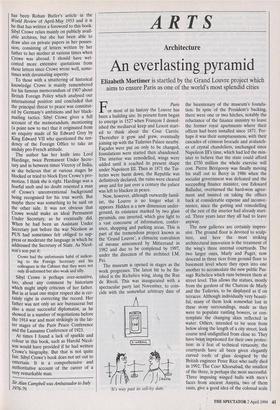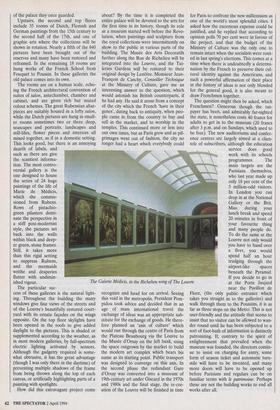ARTS
Architecture
An everlasting pyramid
Elizabeth Mortimer is startled by the Grand Louvre project which aims to ensure Paris as one of the world's most splendid cities F Paris
or most of its history the Louvre has been a building site. Its present form began to emerge in 1527 when Francois 1 demol- ished the mediaeval keep and Lescot start- ed to think about the Cour Carree. Thereafter it grew and grew, eventually joining up with the Tuileries Palace nearby. Facades were put on only to be changed, foundations were started then abandoned. The interior was remodelled, wings were added until it reached its present shape under Napoleon III. Then in 1871 the Tui- leries were burnt down, the Republic was definitively declared, the ruins were cleared away and for just over a century the palace was left to blacken in peace.
Now, however, although outwardly famil- iar, the Louvre is no longer what it appears. Hidden is a new dimension under- ground, its existence marked by two glass pyramids, one inverted, which give light to a vast concourse of information, confer- ence, shopping and parking areas. This is part of the tremendous project known as the `Grand Louvre', a climactic convulsion of travaux announced by Mitterrand in 1982 and due to be completed by 1997, under the direction of the architect I.M. Pei.
The museum is opened in stages as the work progresses. The latest bit to be fin- ished is the Richelieu wing, along the Rue de Rivoli. This was inaugurated with a spectacular party last November, to coin- cide with the somewhat arbitrary date of 'It's way past its sell-by date.' the bicentenary of the museum's founda- tion. In spite of the President's backing, there were one or two hitches, notably the reluctance of the finance ministry to leave the former royal apartments where their offices had been installed since 1871. Per- haps it was their sumptuousness, with their cascades of crimson brocade and avalanch- es of crystal chandeliers, unchanged since Napoleon Ill's time, which had led the min- ister to believe that the state could afford the £750 million the whole exercise will cost. Pierre Beregovoy was finally moving his staff out to Bercy in 1986 when the socialist government was defeated and the succeeding finance minister, one Edouard Balladur, overturned the hard-won agree- ment and insisted on taking the offices back at considerable expense and inconve- nience, since the gutting and remodelling of the rest of the interior had already start- ed. Three years later they all had to leave anyway.
The new galleries are certainly impres- sive. The ground floor is devoted to sculp- ture, and here the most striking architectural innovation is the treatment of the wing's three internal courtyards. The two larger ones, Marly and Puget, now descend in three tiers from ground floor to basement level where they open into one another to accomodate the new public Pas- sage Richelieu which runs between them at street level. This allows the statues, mostly from the gardens of the Chateau de Marly and the Tuileries, to be displayed as if on terraces. Although individually very beauti- ful, many of them look somewhat lost in these stony surroundings, made as they were to populate rustling bowers, or con- template the changing skies reflected in water. Others, intended to be seen from below along the length of a city street, look coarse and undignified from close to. They have been imprisoned for their own protec- tion: in a feat of technical virtuosity, the courtyards have all been given elegantly curved roofs of glass designed by the British engineer Peter Rice who sadly died in 1992. The Cot" Khorsabad, the smallest of the three, is perhaps the most successful. Three imposing winged bulls with men's faces from ancient Assyria, two of them casts, give a good idea of the colossal scale of the palace they once guarded.
Upstairs, the second and top floors include 35 rooms of Dutch, Flemish and German paintings from the 15th century to the second half of the 17th, and one of graphic arts where the collections will be shown in rotation. Nearly a fifth of the 840 pictures have been brought out of the reserves and many have been restored and reframed. In the remaining 18 rooms are hung works of the French School from Fouquet to Poussin. In these galleries the old palace comes into its own.
The particular suc- cess of these galleries is the natural light- ing. Throughout the building the many windows give fine views of the streets and of the Louvre's beautifully restored court- yard with its ornate facades on the wings opposite. On the top floor skylights have been opened in the roofs to give added daylight to the pictures. This is shaded or supplemented according to the weather, as in most modern galleries, by full-spectrum electric lighting activated by sensors. Although the gadgetry required is some- what obtrusive, it has the great advantage (though I was only there in the daytime) of preventing multiple shadows of the frame from being thrown along the top of each canvas, or artificially highlighting parts of a painting with spotlights.
How did this extravagant project come about? By the time it is completed the entire palace will be devoted to the arts for the first time in its history, though its role as a museum started well before the Revo- lution, when paintings and sculpture from the royal collections were intermittently on show to the public in various parts of the building. The Musee des Arts Decoratifs further along the Rue de Richelieu will be integrated into the Louvre, and the Tui- leries Gardens will be restored to their original design by Lenotre. Monsieur Jean- Francois de Canchy, Conseiller Technique at the Ministry of Culture, gave me an interesting answer to the question, which would astonish his British counterparts, if he had any. He said it arose from a concept of the city which the French 'have in their genes', dating back to antiquity, when peo- ple came in from the country to buy and sell in the market, and to worship in the temples. This continued more or less into our own times, but as Paris grew and as pil- grimages went out of fashion, the city no longer had a heart which everybody could Galerie Medici's, in theRichelieu wing of The Louvre The recognize and head for on arrival. Seeing this void in the metropolis, President Pom- pidou took advice and decided that in an age of mass international travel the exchange of ideas was an appropriate sub- stitute for the exchange of goods. He there- fore planned an `axis of culture' which would run through the centre of Paris from the Plateau Beaubourg via the Louvre to the Musee d'Orsay on the left bank, using the space outgrown by the market to build the modern art complex which bears his name as its starting point. Public transport was designed to converge on this axis. In the second phase the redundant Gare d'Orsay was converted into a museum of 19th-century art under Giscard in the 1970s and 1980s and the final stage, the re-cre- ation of the Louvre will be finished in time for Paris to confront the new millennium as one of the world's most splendid cities. I asked how the enormous expense could be justified, and he replied that according to opinion polls 70 per cent were in favour of the project, and that the budget of the Ministry of Culture was the only one to remain intact when the socialists were rout- ed in last spring's elections. This comes at a time when there is undoubtedly a determi- nation by the French to preserve their cul- tural identity against the Americans, and such a powerful affirmation of their place in the history of ideas is not only blended for the general good, it is also meant to draw Frenchmen together.
The question might then be asked, which Frenchmen? Generous though the tax- payer has been, and admirably far-sighted the state, it nonetheless costs 40 francs for adults to get in to the museum (20 francs after 3 p.m. and on Sundays, which used to be free). The new auditoriums and confer- ence centres are largely aimed at a clien- tele of subscribers, although the education service does good work with its schools programmes. The main targets are the Parisians themselves, who last year made up only 18 per cent of the 5 million-odd visitors. In London you can drop in at the National Gallery or the Brit. Mus. during your lunch break and spend 20 minutes in front of your favourite thing and many people do. To do the same at the Louvre not only would you have to hand over a fiver, you would spend half an hour trudging through the airport-like - spaces beneath the Pyramid. If you decide to go in at the Porte Jaujard near the Pavilion de Fiore, (the only public entrance which takes you straight in to the galleries) and walk through them to the Poussins, it is as far as three stops on the Metro. This is not user-friendly and the attitude that seems to insist that no visitor can be allowed to wan- der round until he has been subjected to a sort of foot-bath of information is distinctly patronizing. If, contrary to the spirit of enlightenment that prevailed when the museum was founded, the directors contin- ue to insist on charging for entry, some form of season ticket and automatic turn- stile will have to be invented, and many more doors will have to be opened up before Parisians and regulars can be on familiar terms with le patrimoine. Perhaps these are not the building works to end all works after all.



























































 Previous page
Previous page